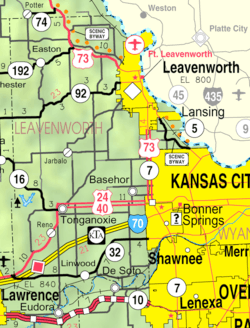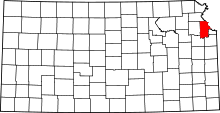Basehor, Kansas
| Basehor, Kansas | |
|---|---|
| City | |
 Location within Leavenworth County and Kansas | |
 KDOT map of Leavenworth County (legend) | |
| Coordinates: 39°8′18″N 94°56′19″W / 39.13833°N 94.93861°WCoordinates: 39°8′18″N 94°56′19″W / 39.13833°N 94.93861°W | |
| Country | United States |
| State | Kansas |
| County | Leavenworth |
| Established | 1889 |
| Government | |
| • Type | Mayor–Council |
| • Mayor | David K. Breuer |
| Area[1] | |
| • Total | 6.75 sq mi (17.48 km2) |
| • Land | 6.68 sq mi (17.30 km2) |
| • Water | 0.07 sq mi (0.18 km2) |
| Elevation | 981 ft (299 m) |
| Population (2010)[2] | |
| • Total | 4,787 |
| • Estimate (2015[3]) | 5,402 |
| • Density | 710/sq mi (270/km2) |
| Time zone | Central (CST) (UTC-6) |
| • Summer (DST) | CDT (UTC-5) |
| ZIP code | 66007 |
| Area code | 913 |
| FIPS code | 20-04400 |
| GNIS feature ID | 0478554 [4] |
| Website | CityOfBasehor.org |
Basehor is a city in Leavenworth County, Kansas, United States and is a suburb of the Kansas City Metropolitan Area. As of the 2010 census, the city population was 4,613.[5]
History
In exchange for extensive Delaware holdings in the state of Indiana, on September 24, 1829, the United States Government ceded a large tract of land to the Delaware Indians. Basehor is built on a small part of this tract. The Delawares held this land, or at least parts of it, until the 1860s. On July 4, 1866, the Secretary of the Interior of the United States was offered for sale what was left of the Delaware lands, then referred to as the Delaware Diminished Reserve, for not less than $2.50 per acre. The Leavenworth, Pawnee, and Western Railroad Company subsequently bought all of the remaining land on January 7, 1886.
The first individuals to own the land upon which Basehor now stands were Thomas Salem and Mary Z. Towne (though William Henery Lewis, who surveyed for the Railroad,bought an extensive plot on land to the northeast of Basehor around 1861 and homsteaded it right after the civil war) The couple bought it from the railroad in 1873 and mortgaged it to Ephraim Basehor the same year. On January 9, 1874, the Townes sold the 160 acres (0.65 km2) to Basehor.
Basehor was founded in 1889 by Reuben Basehor and his brother Ephraim. They both were of Pennsylvania Dutch descent and came to Kansas in 1854. After living in Lawrence for a time, Ephraim began working as a hired hand for an area farmer. He eventually bought the farm and other land holdings in the area.
In 1889, the railroad was completed and Ephraim plotted his land and began building the town site. It was dedicated on November 30, 1889, and was named after Basehor.
Ephraim Basehor donated the land for the school house around 1900. The old grade school was located north of town and was originally called the Prairie Garden District #32. The first high school classes in the community met in 1905 above the Kemler-Hammond General Store. In 1906, a building was erected to house the high school and grade school. It was built for K-12 on the southeast corner of 155th Street and Leavenworth Road. The high school was upstairs, and K-8 was located in the three classrooms downstairs. In 1929, there were 5 graduates.
Reuben Basehor donated $1,000 to the school to build a library which was a cement structure east of the old school, which still stands. A new two-story brick high school was built as a W.P.A. project in 1938. The grade school classes continued to be held in the old building until a new grade school was built in 1955. By 1963, a new high school was built, and the older building was taken over by the top two grades of the grade school.
Geography
Basehor is located at 39°8′18″N 94°56′19″W / 39.13833°N 94.93861°W (39.138469, -94.938735).[6] According to the United States Census Bureau, the city has a total area of 6.75 square miles (17.48 km2), of which, 6.68 square miles (17.30 km2) is land and 0.07 square miles (0.18 km2) is water.[1]
Demographics
| Historical population | |||
|---|---|---|---|
| Census | Pop. | %± | |
| 1970 | 724 | — | |
| 1980 | 1,483 | 104.8% | |
| 1990 | 1,591 | 7.3% | |
| 2000 | 2,238 | 40.7% | |
| 2010 | 4,613 | 106.1% | |
| Est. 2015 | 5,402 | [7] | 17.1% |
| U.S. Decennial Census[8] 2012 Estimate[9] | |||
2010 census
As of the census[2] of 2010, there were 4,613 people, 1,751 households, and 1,337 families residing in the city. The population density was 690.6 inhabitants per square mile (266.6/km2). There were 1,881 housing units at an average density of 281.6 per square mile (108.7/km2). The racial makeup of the city was 94.1% White, 2.5% African American, 0.4% Native American, 0.5% Asian, 0.5% from other races, and 1.9% from two or more races. Hispanic or Latino of any race were 3.6% of the population.
There were 1,751 households of which 37.4% had children under the age of 18 living with them, 62.8% were married couples living together, 9.4% had a female householder with no husband present, 4.1% had a male householder with no wife present, and 23.6% were non-families. 19.3% of all households were made up of individuals and 7.7% had someone living alone who was 65 years of age or older. The average household size was 2.63 and the average family size was 3.02.
The median age in the city was 37.6 years. 26.5% of residents were under the age of 18; 6% were between the ages of 18 and 24; 28.4% were from 25 to 44; 27% were from 45 to 64; and 12.2% were 65 years of age or older. The gender makeup of the city was 48.5% male and 51.5% female.
2000 census
As of the census of 2000, there were 2,238 people, 830 households, and 650 families residing in the city. The population density was 712.3 people per square mile (275.2/km²). There were 848 housing units at an average density of 269.9 per square mile (104.3/km²). The racial makeup of the city was 97.1% White, 0.4% African American, 0.3% Native American, 0.7% Asian, <0.1% Pacific Islander, 0.5% from other races, and 0.9% from two or more races. Hispanic or Latino of any race were 1.6% of the population.
There were 830 households out of which 36.3% had children under the age of 18 living with them, 64.5% were married couples living together, 11.1% had a female householder with no husband present, and 21.6% were non-families. 19.3% of all households were made up of individuals and 9.0% had someone living alone who was 65 years of age or older. The average household size was 2.70 and the average family size was 3.09.
In the city the population was spread out with 27.2% under the age of 18, 8.4% from 18 to 24, 28.1% from 25 to 44, 23.8% from 45 to 64, and 12.6% who were 65 years of age or older. The median age was 37 years. For every 100 females there were 90.8 males. For every 100 females age 18 and over, there were 87.4 males.
The median income for a household in the city was $52,831, and the median income for a family was $60,000. Males had a median income of $40,540 versus $27,708 for females. The per capita income for the city was $20,731. About 2.8% of families and 4.1% of the population were below the poverty line, including 4.7% of those under age 18 and 6.4% of those age 65 or over.
References
- 1 2 "US Gazetteer files 2010". United States Census Bureau. Archived from the original on 2012-01-24. Retrieved 2012-07-06.
- 1 2 "American FactFinder". United States Census Bureau. Retrieved 2012-07-06.
- ↑ "Population Estimates". United States Census Bureau. Retrieved 2016-08-21.
- ↑ "US Board on Geographic Names". United States Geological Survey. 2007-10-25. Retrieved 2008-01-31.
- ↑ "2010 City Population and Housing Occupancy Status". U.S. Census Bureau. Archived from the original on 21 July 2011. Retrieved June 14, 2011.
- ↑ "US Gazetteer files: 2010, 2000, and 1990". United States Census Bureau. 2011-02-12. Retrieved 2011-04-23.
- ↑ "Annual Estimates of the Resident Population for Incorporated Places: April 1, 2010 to July 1, 2015". Retrieved July 2, 2016.
- ↑ United States Census Bureau. "Census of Population and Housing". Archived from the original on May 11, 2015. Retrieved October 24, 2013.
- ↑ "Annual Estimates of the Resident Population: April 1, 2010 to July 1, 2012". Retrieved October 24, 2013.
Further reading
- County
- History of Leavenworth County Kansas; Jesse Hall and LeRoy Hand; Historical Publishing; 684 pages; 1921. (Download 27MB PDF eBook)
- Kansas
- History of the State of Kansas; William G. Cutler; A.T. Andreas Publisher; 1883. (Online HTML eBook)
- Kansas : A Cyclopedia of State History, Embracing Events, Institutions, Industries, Counties, Cities, Towns, Prominent Persons, Etc; 3 Volumes; Frank W. Blackmar; Standard Publishing Co; 944 / 955 / 824 pages; 1912. (Volume1 - Download 54MB PDF eBook),(Volume2 - Download 53MB PDF eBook), (Volume3 - Download 33MB PDF eBook)
External links
| Wikimedia Commons has media related to Basehor, Kansas. |

